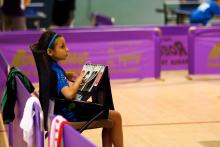Devastate the Offensive Chopper
There are many different types of choppers; however, I’m going to lump all the choppers together into two categories – offensive choppers and defensive choppers. Today, I’ll be talking about the offensive chopper, he likes to go back from the table, chopping with pips on his backhand, while fishing and counterlooping with his forehand. Even though he is away from the table, he is looking for the opportunity to move in and smash with his backhand or loop with his forehand. He wins about half of his points with consistency and half with his power shots. If you are having a difficult time picturing this style, I recommend that you watch some youtube videos or Hou Yingchao or Chen Weixing. Watch how they win points with offense and defense and watch how they are looking for every opportunity to step in and rip a winner.
Tactics:
Rubber
Before starting the match, make sure that you inspect your opponent’s rubber – especially the backhand side to see if he is using short pips or long pips and to see if it has sponge and to see if it has friction or not. (Please refer to the long pips article to understand the difference between pips with more or less friction). Also, during the course of the match, watch your opponent carefully to see which side of the racket he is using. Choppers are very good at twiddling so that they can use inverted or pips on the backhand.
Consistency
At the start of the match, try to evaluate your own consistency as well as your opponent’s consistency. If you are more consistent, then focus on playing steady and allow the chopper to panic while going for wild shots. If your opponent is more consistent, then you will need to find ways to finish the point early or give enough variations to lower his consistency.
Opportunity
Choppers prefer to push, chop, and loop deep. It is vitally important that you be able to move in-and-out against a chopper. If he mistakenly chops a ball short, you should see the opportunity and move in for a stronger loop. If he fishes or counterloops, you will likely need to move back slightly to continue looping, if he chops again, you will need to move forehand to continue looping. This is one of the main differences of playing a chopper vs playing an offensive looper. Typically when playing topspin, you prefer to stay about the same distance from the table. When playing a chopper, you often need to move in-and-out, out-and-in, in-and-out, out-and-in based on which shot he plays and the depth, height, and spin quality of the shot.
Transition Point
When attacking, the main location to loop the ball is spinny to the middle transition point. Sometime it will take about 8-10 loops to win a point spinning over and over again to the backhand. Sometimes you may not want to risk going to the wide forehand because you are afraid of the counterloop, so often the middle will be your preferred location. When you loop spinny and deep to the middle and your opponent decides to backhand chop, he will then be slightly out-of-position for the next ball. The next ball you should loop slightly further to the forehand (about 3-4” further to the forehand) or possibly target the wide angle backhand. Regardless of what you choose next, you are forcing him to move into an awkward position in the middle. When you loop spinning and deep to the middle and your opponent decides to forehand counterloop, this will again be an awkward ball for him because he is contacting the spinniest back location on the ball. Most counterlooping choppers prefer to reach to the forehand and contact the side of the ball for a lateral sidespin counterloop; this makes is much easier to counterloop because they will only be feeling about 50% of the spin when contacting the side of the ball. For this reason, most of your loops should be spinny to the transition point.
Short Forehand
It is difficult and sometimes unnecessary to continually loop over and over again. Sometime you need to push short to bring the chopper in. If you push short and low to the forehand, the chopper will have an awkward time smashing the low ball. Once you bring him forward, then try to attack the middle or wide backhand.
Deep Backhand
If you loop deep and he chops deep, it will be difficult for you to push short. If you choose to push and can’t go short, then usually pushing deep to the backhand is preferred. Even if the chopper knows how to backhand loop, it is very difficult to move in from 12’ back and backhand loop. The only time that I would recommend pushing deep to the forehand is when the chopper is looking to pivot from the backhand side and play a strong forehand loop from the backhand.
Plan B
Typically, the offensive chopper can adjust his style playing more aggressively with his forehand counterloop, more passively with fishing and chopping, or even go to blocking from near the table. As the match progresses, you also need to be willing to evaluate and re-evaluate the situation. Just because you won the first game 11-1, doesn’t necessarily mean that that particular tactic will work the entire match. Take your time between point, re-evaluate, and play smart to beat the offensive chopper.




